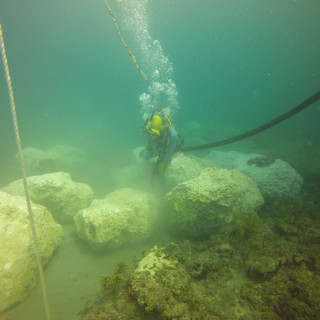"Living Shorelines" Conservation: Callaway Marine & Reef Life Engineering
- MSB Reef Life
- Jul 13, 2017
- 3 min read
Living Shorelines: Personifies Next Phase Seawalls, and Coastline Conservation.
Callaway provides highest quality technical solutions for a variety of environmental marine and coastal projects, with the primary focus on environmentally sensitive projects. These include consulting, restoration and mitigation projects that take place near protected resources, including coral reefs, seagrass, mangroves and wetlands.
Reef Life has chosen Callaway for their depth of experience, educational and coral expertise, as well as big Barge Deployment in oceanic conditions. The habitats for estuarine species create sustainability in the form of "Living Shoreline" Seawalls. Reef Life experts create the voids for creature growth and correct textures and oceanic motifs within a more natural bank stabilization.
Shorelines have previously been stabilized with hardened structures, such as bulkheads, revetment, and concrete seawalls. Ironically, these structures often increase the rate of coastal erosion, remove the ability of the shoreline to carry out natural processes, and provide little habitat for estuarine species. Reef Life and Callaway are working to implement a more natural bank stabilization technique called “living shorelines.” This approach uses plants, sand, and limited use of rock to provide shoreline protection and maintain valuable habitat.
Living shoreline projects utilize a variety of structural and organic materials, such as wetland plants, submerged aquatic vegetation, oyster reefs, coir fiber logs, sand fill, and stone. The benefits of living shorelines include:

Stabilization of the shoreline.
Protection of surrounding riparian and intertidal environment.
Improvement of water quality via filtration of upland run-off.
Creation of habitat for aquatic and terrestrial species.
Callaway has provided mitigation required for dredging, beach nourishment and other construction contracts. In addition, CMT personnel have successfully conducted a variety of environmental monitoring services including turbidity monitoring for dredging projects and natural resource surveys including seagrass surveys, natural hardbottom monitoring, benthic resource surveys, and monitoring of artificial and natural coral reef habitats.
Callaway team has experience with many “firsts” and pioneering projects in coral reef restoration, seagrass restoration and other environmental mitigation projects. CMT recently completed the construction of a 11.6 acre artificial reef for mitigation for the Miami Harbor Phase III Deepening Project; a dredging project by the United States Army Corps of Engineers (USACE).
CMT has successfully performed a variety of different underwater construction, installation and structure repair projects. All our personnel are carefully selected for their experience and qualifications. Our team has completed the construction of a variety of different structures including; bridges, docks, piers and jetties. We have performed underwater repairs on pump stations, bridges, seawalls, bulkheads, boat ramps, boat locks and other water control and marine structures. In addition, the CMT team has successfully completed offshore outfall pipeline installations. Our team has extensive concrete experience, including new construction and underwater concrete repairs using varying types of concrete, and specialty mixes.
Callaway Marine Technologies Inc. (CMT) provides engineering and consulting services to government agencies, private entities and other engineering and construction firms. Our firm specializes in providing innovative engineering solutions to coastal and offshore problems. CMT also provides consulting services for environmental projects with special emphasis on developing plans, construction methods, logistics and equipment operation for work that takes place in or near environmentally sensitive areas. The firm has provided engineering and consulting services for reef restoration projects associated with ship groundings and anchor damage.
#ReefEngineering #CallawayMarine #coastalreconstruction #coralconservation #coastlineprotection #reefconservation #seawallconstruction #FloridaNOAACorals #offshoreunderwaterconstruction #LivingShoreline #httpwwwhabitatnoaagovrestorationtechniques #seawalls #estuarinespecies #NOAA #intertidalenvironment #coastalconservation
















Comments